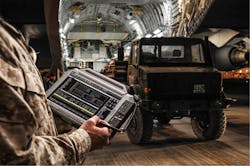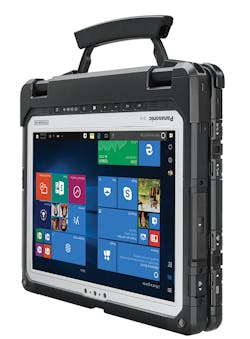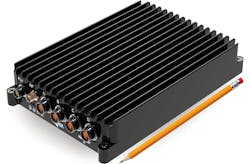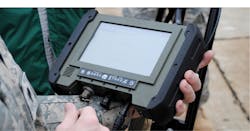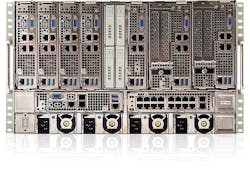Rugged computers for mobile missions
Deployed forces rely on rugged computers with the latest processing and data storage to bring impressive capabilities to missions on the move.
By Courtney E. Howard
The demand for data in the field is at an all-time high - and still growing. A vast majority of mission- and safety-critical aerospace and defense applications rely on fast, fail-safe access to key information, emphasizing the need for rugged, reliable, high-performance mobile computing devices in even the harshest environments.
Xplore XC6 series ultra-rugged tablet PCs are designed for use in extreme conditions and tested to MIL-STD-810G and IP67 standards.
A mass migration from paper-based to digital information is driving the need for capable rugged mobile computers throughout aerospace and defense applications in virtually all locales, including land, sea, air, and space.
Right now, defense is moving to tablet and 2-in-1 personal computers (PCs), which are bridging the gap from paper to digital and also from traditional clamshell products to tablet-type products, says James Poole, federal sales director at Panasonic in Newark, N.J., the company's North American headquarters.
"When you look at maintenance and software in aerospace and defense, aircraft and applications might be 20 years old," and are now migrating to touchscreen interfaces and ruggedized PCs, Poole explains. "All branches of the military and homeland security are adopting ruggedized systems. Smaller form factors, lighter form factors in the ruggedized world, including man-packable and wearable computers, are making things easier logistically."
A popular area for ruggedized laptops is flight-line and field maintenance for military aircraft and land vehicles. Overwhelmingly, Poole says, "maintenance professionals are migrating from pen and paper and actively digitizing preflight inspections," for example. "In general, some logistics applications are moving from handheld barcode readers to smart tablets - Microsoft Windows-based devices that will not only read a barcode or RFID tag, but give them more capabilities and make them more efficient."
Battlefield communications
Rugged tablets and small wearable PCs connected to satellite communications (SATCOM) are facilitating in-theater communications on the battlefield, and growing situational awareness through shared mapping data, images, and videos fed from an unmanned aerial vehicle (UAV) or command and control center, Poole explains. From a battlefield communications standpoint, fast, lightweight, rugged PCs and wearable computers are bringing more intelligence and situational awareness in the field, he adds.
Rugged computers increasingly are being used for border security at points of entry, at civilian airfields, in the Department of the Interior and Department of Transportation during safety inspections, and mounted in vehicles for police, park rangers, and other public safety uses, Poole says.
Power and thermal management are critical considerations when selecting computer systems for aerospace and defense applications. "When designing a rugged system, it's very important that it span the entire thermal range," such as flight-line applications at military bases from freezing-cold Alaska to scorching-hot Yuma, Ariz., Poole says. "Intel is designing processors that are faster, generate less heat, and require less power to run. Panasonic is designing rugged systems around Intel architecture to provide longer battery life in the field and better performance."
Rugged performance in mobile environments has improved considerably the past few years. Nonetheless, "when evaluating a mobile computer or tablet, make sure you're evaluating the system under the conditions it's going to be used," Poole recommends. "Testing in an IT environment is very different than testing a system in a high-altitude aviation environment or the desert. Make sure you're testing with the intended users and environments in mind."
Crystal Group RS255 is deployed on Navy MQ-8 Fire Scout unmanned autonomous helicopters.
IoT on tablets
Aerospace and defense applications are moving toward Internet of Things (IoT) and cloud-based solutions with the help of rugged mobile computers. In the military sector, "IoT technology is being leveraged during battle coordination scenarios," says John Graff, vice president of marketing at Xplore Technologies Corp. in Austin, Texas. "So, we've ensured each of our devices and their accessories are future-proof and scalable to achieve interoperability with other IoT-enabled technologies during these simulations."
Demand for rugged tablets also is up in applications such as command and control; communications; remote weapons control; unmanned aircraft control; and tactical geospatial intelligence, Graff says.
Customized XC6 M2 tablet computers from Xplore are part of a U.S. military mobility project, started in 2012. To date, the customer has purchased more than 3,000 customized Xplore XC6 ultra-rugged tablet PCs collectively worth more than $10 million and deployed for data collection in the field. Data collection is happening virtually everywhere the military is, so rugged system designs that meet environmental demands are key.
"We've always worked closely with our military field operator customers so that we can fine-tune our devices to withstand the most rugged environments, such as those with extreme temperatures," Graff says. "By leveraging customer feedback, we've developed our rugged tablets with thermal management designs to regulate temperature with unique remote heat exchanger technology, which ensures that processors are operable at full speed while at higher ambient temperatures.
"The real challenge here is not only to protect the electronic components from internal heating but also from external temperature," Graff continues. "Many of our rugged tablets are designed with an innovative internal cooling design, tested and certified for temperatures going from -35 up to 60 degrees Celsius.
"Other important challenges and considerations when designing our rugged devices include drop impact, vibration, aftershock, and fluid and dust contamination," Graff adds. Military forces worldwide use Xplore ultra-rugged tablets "because they are also certified up to IP67 and MIL-STD-810" environmental standards.
Mobile data centers
"The high-performance embedded computing (HPEC) trend has migrated from purpose-built expensive VME/VPX-style, ATR-type chassis into these small-form-factor battlefield mobile data centers," says Chris Ciufo, chief technology officer at General Micro Systems (GMS) in Rancho Cucamonga, Calif.
These rugged systems, in rack-mount and conduction-cooled versions, "are, at their core, processing servers based upon one or more Intel Xeon E5 or Xeon D server-class CPUs," Ciufo says. "They run heavyweight applications like data mining, image recognition, or any manner of algorithm processing. They also virtualize CPUs and I/O for use with attached clients. Increasingly, they also have multi-port 1 Gigabit or 10 Gigabit Ethernet switches."
GMS is shipping air-cooled and conduction-cooled rugged mobile computer systems with more than 20 Ethernet ports and running at least that many virtual machines, Ciufo says. Company engineers can add one, two, four, or more commercial off-the-shelf (COTS) PCI Express general-purpose graphics processing unit (GPGPU), field-programmable gate array (FPGA), or switched mezzanine card/FPGA mezzanine card (XMC/FMC) co-processing modules for deep learning, data mining, search and rescue, sonar, software-defined radio, and all manner of algorithm co-processing to supplement the main Intel Xeon processors, he explains. For example, the company's S2U server can accommodate two Nvidia Titan V GPGPUs, each capable of 110 teraflops (TFLOPS) or 110 trillion floating-point operations per second.
Panasonic Toughbook 33 can be used as a tablet and put in clamshell mode for easy transport.
High speeds, low SWaP
As mobile data centers, "these servers are doing more than offering CPU cycles; they're receiving, processing, and storing data from sensors and from elsewhere on a network," Ciufo notes. "An important attribute of this rugged server class is having a massive amount of fast, low-latency storage." GMS uses Non-Volatile Memory Express (NVMe) solid-state drives (SSDs) because they communicate with the CPUs at PCI Express Gen3 speeds, or 8 gigatransfers per second, which alleviates the need for drive controllers that slow data throughput and add unnecessary controller latency, he says.
"One of our smallest conduction-cooled server systems has two removable and two fixed drives; our most equipped server has at least 14 drives, and each drive stores more than 16 terabytes. That's cloud-sized storage that can be vehicle-, airframe-, or UAV-mounted in a very small space. In fact, it's a rack's worth of equipment in a fraction of the space," Ciufo says. "With this class of mobile data center, a single server can replace up to 36 separate, stand-alone, Windows-equivalent computers. The size, weight, and power (SWaP) benefit is obvious: One machine saves the weight, heat, and size of up to 36 others. And the cost benefit is enormous."
The Warfighter Information Network-Tactical (WIN-T) Increment 2 program with the U.S. Army and General Dynamics Mission Systems in Fairfax, Va., uses the conduction-cooled SB2002-SW Blackhawk rugged computer from GMS. The server is Intel Xeon D-based, runs virtual machines, and has an enterprise-class Cisco software router installed by General Dynamics. "This single small-form-factor (SFF) server replaces four and five separate systems, depending upon the vehicle, of the previous WIN-T Increment 1 implementation," Ciufo says.
"One small conduction-cooled or rack-mount mobile data center server does the processing, storage, networking, VMs, and data mining/algorithm processing of a full rack's worth of data center equipment - but it's deployable on the battlefield," Ciufo explains.
COTS-based mobile data centers
As military planners worry about so-called "near-peer" future conflicts against adversaries that are as committed, capable, and nearly as well-funded as America, Ciufo says, two trends might reshape thinking about mobile data center architectures: denial of service and battle damage.
For a couple of decades, the digital battlefield has been all about "connectedness," Ciufo says. "The Army's WIN-T was certainly built with this in mind, but planners are concerned about losing connectedness if a sophisticated adversary impacts our network. For mobile servers and their workloads, this means that every intelligent and well-equipped U.S. asset on the battlefield needs to have enough information in its vehicle/platform to work autonomously but coordinated with other assets. This might mean distributed databases and enough storage at each node.
"There also needs to be a way to keep those databases in sync without overloading the operational network with useless or redundant data," Ciufo continues. "This technology exists today: Media streaming companies like Amazon and its customer Netflix do this to serve huge amounts of content to millions of households on bandwidth-limited wired and wireless networks.
"Secondly, with so much intelligence resident in each platform, there's some concern about battle damage," Ciufo says. "Can one hit take out the server and render the platform essentially not useful to the battle? Fault tolerance, within the vehicle and among assets, starts to become a concern. Perhaps there needs to be two mirrored mobile data center servers per platform, completely in sync, with each ready to pick up the load should the other become damaged. The whole system architecture needs to be re-examined, as might the server's architecture."
Technologies, architectures, and software that consider loss of communications and fault tolerance might become hot areas for embedded defense suppliers in the coming years, Ciufo predicts. "At GMS, we're already considering what this means to our COTS mobile data center servers."
Enabling autonomy
The demand for autonomous and unmanned system technology is exploding right now, says Chip Thurston, chief architect at Crystal Group Inc. in Hiawatha, Iowa. Technology companies worldwide are working to bring automated driving systems to fruition across several environments, from city streets to airport tarmacs, military bases, and beyond, including the battlefield.
"Currently, it takes a lot of brute-force computing to accomplish the tasks required to make autonomous driving safe. As the technology matures, the rules and laws get firmed up, the compute needs will go down, and we will be able to write more effective code, offload computationally intense tasks to specialized FPGAs or custom silicon, and things will get smaller again," Thurston predicts.
Crystal Group's rugged servers are in several autonomous vehicles as well as in U.S. military unmanned systems on land, sea, and air. Through its partnership with Intel, Crystal Group produced reliable and rugged server technology designed for safety and security in volatile environments. The Crystal RS363S15F 3U rugged server is customized for autonomous vehicles in aerospace, defense, government, industrial, and commercial applications, and can withstand high shock and vibration and a wide temperature range. Crystal Group's RS363S15F won a Gold Innovation Award from Military & Aerospace Electronics and Intelligent Aerospace. (Read about it and the other award winners online at http://bit.ly/2kTvkRl.)
Rugged autonomous computers are not without their design challenges, including power and thermal management. "The power draw for some of these systems is in excess of 2.5 kilowatts. This is required to do the level of computing needed, as well as keeping the system redundant so that a single point of failure does not compromise the integrity of the autonomous experience," Thurston explains.
"Running a system with high-end GPUs, FPGAs, and high-power CPUs means you need a good mechanical package to prevent damage to the compute components, as well as a top-notch thermal solution to keep the system from overheating," Thurston says. "Ideally, you want to figure out a way to get the heat and fan noise out, so that you are not heating [the interior] of the vehicle, and this often takes specialized cooling techniques."
Themis Computer's Nanopak i7 is used in unmanned vehicles and man-wearable applications.
Crystal Group designs liquid-cooled computationally intense systems designed to survive harsh desert environments, as well as to resist the effects of sand, dust, and rain, Thurston says, while tapping the latest commercial technologies, such as hyperconverged infrastructure (HCI), NVMe SSDs, Nvidia Tesla GPU accelerators, and Intel Xeon CPUs.
Performance and portability
Military interest is increasing in rugged GPGPU systems, high-density computing and storage clusters, and hyperconverged infrastructure for sensor fusion, virtualization, data analytics, and data security or encryption, Waiming Mok, technical marketer at Themis Computer in Fremont, Calif. "Users want systems that can do more in the same physical space without adding weight or requiring more power."
(Editor's note: Mercury Systems in Andover, Mass., announced plans in late December to acquire Themis Computer for $180 million in cash.)
The Themis RES-NT2 is designed to meet the de-manding requirements of rugged environments.
More often than not, rugged mobile computers are being used in applications that value mobility and SWaP over other features, Mok says. The company's Nanopak i7 small-form-factor computer is for unmanned vehicles and wearable applications, whereas its NanoSwitch with an embedded processor is designed in to the Joint Light Tactical Vehicle (JLTV) from Oshkosh Corp. in Oshkosh, Wis. Aerospace and defense users, like those in other markets, want high performance and data storage without sacrificing mobility, Mok says, for which the company's recently launched RES-XR6 1U 8-drive server, which features Intel Xeon Scalable Processors, has been very popular.
"In the rugged space, there is always a need for design engineering and thermal management - not only to ensure optimal performance in non-ideal environments (extreme temperatures, dust, water, humidity, altitude), but also to minimize size, weight, and power of the system itself," Mok explains. "We work closely with each customer to configure and design systems that balance technology, rugged requirements, and SWaP according to their needs."
For GPGPU computing, Themis engineers use advanced mechanical and electrical engineering techniques such as specially designed cooling fans to performance degradation when computer throttle-back when they get too hot. Themis optimizes cooling to support operations to 50 degrees Celsius on most multi-core Intel CPUs, and temperatures to 60 degrees Celsisu on select processors, Mok says. "Without the proper engineering expertise, CPU and GPGPU throttling will allow systems to continue operation in higher temperatures, but this will eventually lead to an entire system shut down. This is a risk [customers] cannot take."
A key trend is increasing speed by using NVMe storage, which enables users to collect and analyze data at high speeds by simply replacing a hard drive, Mok says. Similarly, memory requirements of 1.5 terabytes or more are scaling-up to accommodate faster data analytics. "In the aerospace and defense market, many customers like to upgrade components first, as entire system upgrades can be costly." The company's new HDversa server cluster provides "an easy way to upgrade outdated or expensive technology, legacy VME systems in this case, without having to replace the existing infrastructure, such as VME server racks."
Co-processing considerations
"The integration of sensors onboard unmanned vehicles is a driving force in getting more processing and networking capabilities on the platform," says Mike Southworth, product line manager at the Curtiss-Wright Corp. Defense Solutions Division in Salt Lake City. Unmanned systems designers are eying hybrid technologies like using several system architectures and different co-processors mixing CPUs, GPUs, and FPGAs.
Payload mission processing is one of the hottest applications for rugged mobile computers today, and can encompass sensor fusion, machine learning, artificial intelligence, and other key capabilities. "The payloads are specific to each platform, usually consist of computing devices and sensors, and often involve fusing together data from multiple sources and sharing of that data over a network," Southworth says. The rugged mobile computing payload is "the common thread within all these platforms, whether unmanned or manned, and supports the mission-specific purpose of that platform as well as the processing of the data from the sensors."
Hybrid systems take advantage of what is available on the open market for industrial and commercial applications optimized for use in a rugged system for military applications with the lowest SWaP possible. Hybrid systems do this by harnessing the attributes of different form factors. For example, Southworth says, COM Express makes it easier to standardize for thermal management and interconnects: A common carrier board could go from one generation to the next generation and provide a much more direct thermal path for the memory and CPU in the COM Express module to the chassis itself - a passive natural connection.
Many aerospace and defense organizations want to take advantage of co-processing and multiple processing elements in a single system, and many applications are a fit. "Our latest small-form-factor Intel Xeon D-based system not only takes into account multi-core x86 CPU processing but, with the support of an XMC expansion slot, can add in such things as GPGPUs, the Nvidia CUDA development environment for machine learning, Intel's OpenCL architecture for parallel processing, or an FPGA or single-board computers in a mezzanine standard," Southworth explains.
"You could literally have multiple CPUs, such as a low-power mezzanine CPU like an Intel Atom processor or Power Architecture CPU and an ARM processor," Southworth adds. No matter how "that XMC slot is used, it's a very common request for a general-purpose processor like a GPGPU for machine learning, radar processing, and sensor fusion applications within VPX-based architectures that Curtiss-Wright offers and increasingly within form factors smaller than VPX architectures, such as the DuraCOR systems. It's an engine that has so many graphics processor units, so many cores built into it that it really provides a lot of throughput, a lot of bandwidth."
TAG's tactical systems include the TC-301 TAG Commander rugged military-grade tablet with military GPS and civilian GNSS receivers, signal processing, and military-grade wireless radio.
Capitalizing on COTS
Historically, size- and weight-optimized mission computers have been relegated to system management functions. With the advent of Xeon D in a mobile, rugged variant and the ability to combine CPUs, GPUs, and FPGAs, however, engineers now have a viable, deployable, compact solution that offers processing power sufficient for sensor fusion and AI-type applications, Southworth mentions. "It all really comes down to the form factor of the technology and the power dissipation."
Manufacturers have "miniatur-ized the die so the number of cores that can be packed into an IC device is now incredible, and the power consumption has dropped; the amount of power per watt of the system is nothing like we've seen in the past," Southworth says. "In the case of a Xeon D processor with a thermal design power (TDP) rating of just 45 watts, that's comparable to what a Core i7-based system is - so it's very much in the realm of familiar thermal management. Because military and aerospace applications prefer, or at least like to start with, the option of a passively cooled system - because it has a higher mean time between failure (MTBF), is higher-reliability, and doesn't have moving parts or extra thermal management overhead from an integration standpoint - this opens doors. You have low power consumption and high performance in a small package."
Engineers are exploiting the benefits of COTS technology to meet military and aerospace requirements. "The market is not currently maximizing the potential of the Intel Xeon D for rugged systems," Southworth says. "They're typically 32 gigabytes of RAM and tapping out at maybe 64 gigabytes," but 128 gigabytes of RAM are possible.
Curtiss-Wright's DuraCOR XD 1500 mission computer server "brings a massive memory architecture," Southworth says. Its ability to go up to 128 gigabytes of RAM "plays into the capabilities for the sensor and the software, and per core how much memory is allocated and what the application can do with that technology."
Themis HDversa is a high-density, modular rugged computer for tactical platforms.
Conversely, aerospace and defense mobile computers don't necessarily need National Security Agency (NSA) Type 1 encryption, and can get away with commercial-level encryption functionality. "Flash-based SSDs offer various security capabilities, including a fast erase or zeroize capability to erase the data on the drive or even destructive zeroize that renders the disk inoperable - encryption that conforms to the FIPS standards and/or AES 256 standard leveraged in FIPS," Southworth says. "Applications don't have to rely on NSA Type 1 encryption for everything these days because the National Institute of Standards and Technology (NIST) has opened up Commercial Solutions for Classified (CSfC) opportunities, where you could use two layers of encryption for secret applications. There have been great advancements in commercial offerings that enable trusted secure computing and confidence that data in motion and at rest are secured and won't fall into the wrong hands."
Rugged, mobile computers are just one piece of a larger trusted computing environment, upon which mission- and safety-critical applications rely. Continue the security and trusted computing conversation with industry peers at a one-day technical conference from Military & Aerospace Electronics, in Arlington, Virginia, on 13 Nov. 2018. (Visit www.militaryaerospace.com for more information.)
company list
AcroMag
Wixom, Mich.
https://www.acromag.com
ADLINK Technology
San Jose, Calif.
http://www.adlinktech.com
Aitech
Chatsworth, Calif.
http://www.rugged.com
Chassis-Plans
San Jose, Calif.
http://www.chassis-plans.com/
Core Systems
Poway, Calif.
https://core-systems.com
Crystal Group
Hiawatha, Iowa
https://www.crystalrugged.com
Curtiss-Wright
Ashburn, Va.
http://www.curtisswrightds.com
Diamond Systems
Sunnyvale, Calif.
http://www.diamondsystems.com/
Ecrin
Crolles, France
http://www.ecrin.com/en
Elma
Fremont, Calif.
http://www.elma.com
Extreme Engineering Solutions Inc.
Middleton, Wis.
https://www.xes-inc.com
GammaTech Computer Corp.
Fremont, Calif.
https://www.gammatechusa.com
General Micro Systems
Rancho Cucamonga, Calif.
https://www.gms4sbc.com
Getac
Irvine, Calif.
http://www.getac.com
HHCS Handheld USA Inc.
Corvallis, Ore.
https://www.handheldgroup.com
Kontron
Fremont, Calif.
https://www.kontron.com
Mercury Systems
Andover, Mass.
http://www.mc.com
MilDef Inc.
Alexandria, Va.
https://www.mildef.com
Panasonic USA
Newark, N.J.
http://www.toughbook.com
Sparton Rugged Electronics
Woodbridge, Ontario
https://www.spartonre.com
Systel
Sugar Land, Texas
http://www.systelusa.com
Technology Advancement Group (TAG) Inc.
Dulles, Va.
https://www.tag.com
Themis Computer
Fremont, Calif.
https://www.themis.com
V Rose Microsystems
Johnstown, N.Y.
http://www.vrosemicrosystems.com
Xplore
Austin, Texas
https://www.xploretech.com

